How to use digital rainfall gauges and what’s on the market
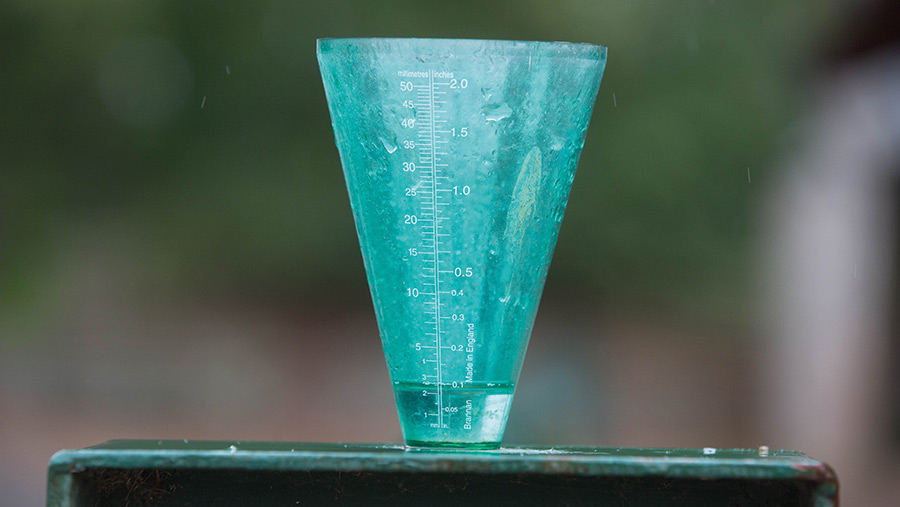 © Tim Scrivener
© Tim Scrivener The rain gauge is one of the easiest tools farmers can use to measure precipitation.
The concept of the original cylindrical cup and funnel design dates back to ancient Greece and the first recorded rain gauges – but since then many different methods of collection have developed.
Some gauges on the market are simple plastic measuring tubes, while others come with outdoor sensors that measure rainfall and transfer that data wirelessly to a console.
See also: Outwintering cattle on kale or grass silage: Which is best?
These digital gauges remove the need for farmers to keep a manual log, improving the functionality and efficiency of their data recording. The best gauges allow farmers to compare data from previous months, or even years.
The most common types of rain gauges are graduated cylinders, weighing gauges or tipping-bucket gauges. Tipping-bucket rain gauges allow rain rates and rain accumulations to be measured at the same time.
The little buckets are like a set of scales that can carry a specific amount of water. When one side of the scale fills with water it tips and empties the water and the other bucket will begin to fill.
How quickly the buckets tip tells us how quickly the rain is falling. How many times the buckets tip in a set amount of time tells us how much rain fell during that time.
Many boast features such as self-emptying rain collectors, high weather resistance, and measure in millimetres, centimetres and inches.
There are many gauges out there that fulfill a range of different needs, depending on the user.
We take a look at what’s on the market when it comes to the more sophisticated digital devices and get advice on where to position them for the most accurate readings and what they can tell you.
Where should you position the rainfall gauge?
Correctly positioning the gauge is important – a good location can make the difference between measuring rain accurately and taking incorrect readings.
- Aim for a height of around 45cm from ground level – low enough to stop the wind blowing the mechanism back and forth and simulating rainfall but sufficiently high to prevent heavy raindrops from bouncing into the rain cone and measuring this as rainfall
- For obvious reasons, make sure it is not sheltered by trees or other objects.
ClimeMET CM7015
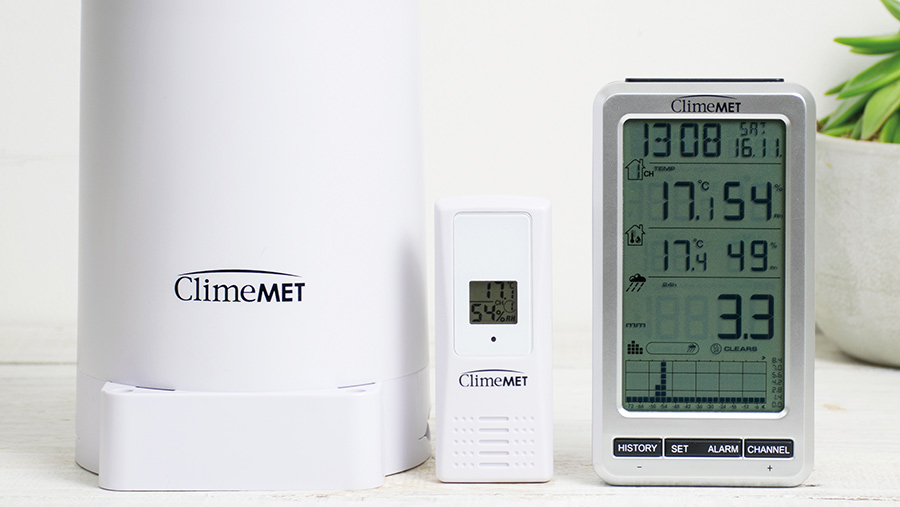
© Metcheck
Designed by a Suffolk-based company, this rain gauge measures rainfall by using a tipping mechanism that moves after 0.3mm or more of rain falls into the rain cone.
Rainfall is measured and data transmitted wirelessly to a display console.
The gauge is self-emptying with water running into side trays where it drains.
Cost
£54.95 on Amazon.
Pros
- Easy-to-use display console
- Straightforward to set up
- Records minimum and maximum values
- Also measures temperature and humidity
- A customisable history graph allows recent data to be viewed
- An option to set custom alerts, such as when it starts to rain.
Rainwatch rain gauge
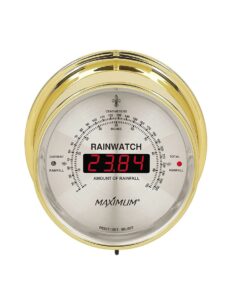
© Metcheck
One of the best-looking gauges on the market, it has a solid brass case and a 12cm diameter dial. However, it also has a hefty price tag.
One of the features that distinguishes it from others on the market is that long- or short-term rainfall data can be reviewed by just moving a switch as it has separate memories for annual rainfall and for weekly or daily rainfall.
This instrument comes with a self-emptying rainfall collector and can be reviewed in millimetres, centimetres and inches.
Cost
£395 on metcheck.co.uk
Pros
- Rainfall data is protected by a 10-year backup to preserve data during power outages
- Maintains proper operation during power outages via 9V battery backup
- Self-emptying collector bucket
- Has a rainfall accuracy +/- 0.25mm of rain
TFA Monsoon wireless rain gauge
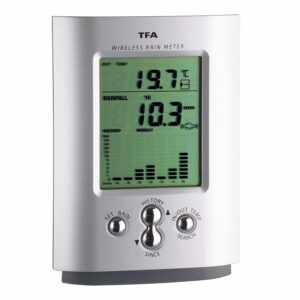
© Metcheck
This is a data-rich gauge that provides rain history for the past hour and 24 hours, as well as the last rainfall with the time and date of when that recording was taken.
There is a rain sensor alarm, and it provides a changing rainfall history graph.
Cost
£50 at www.metcheck.co.uk
Pros
- 30m transmission range in an open field
- A cable-free rain monitor
- Graphical seven-day and monthly records
- Self-emptying rain gauge
- Measures the temperature indoors and outdoors
TFA Drop digital rain gauge
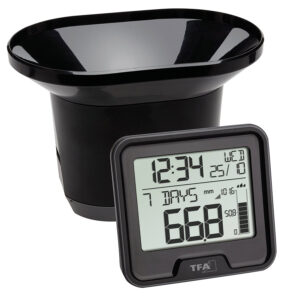
© Metcheck
This gauge has a history function that allows users to compare the amount of precipitation with the monthly values of the previous year.
The amount of rain is visualised on a graph allowing different time periods to be reviewed, such as the last 24 hours of rainfall or the previous seven days.
It provides data on current rainfall amounts, the previous hour, the last 24 hours, seven days and month, as well as the cumulative rainfall.
It has a rain alarm that issues an alert if more rain than an individually set limit falls.
Cost
£39.95 at www.metcheck.co.uk
Pros
- Provides a clear graphical rainfall display
- Self-emptying rain gauge
- Rain sensor alarm
- 100m transmission range in an open field
- Measures in millimetres or inches, with a rainfall range of up to 999mm.
Why should farmers collect rainfall data?
On a grassland farm measuring rainfall can be a baseline for decision-making, explains grassland and forage specialist Charlie Morgan.
Moisture transpires at roughly 2-3mm a day, but this depends on a number of factors, including weather conditions, frequency of rain, the level of soil organic matter and the maximum available water-holding capacity of the soil in the top 10cm.
Soil cover such as grass density and shading are factors too, as these will capture moisture and slow water evaporation.
“Soil moisture meters are the easiest way to help farmers calculate their own farm’s moisture level and work out when growth will start to peter out in a dry spell,’’ says Mr Morgan.
Monthly rainfall averages are good guides for grass growth, alongside soil temperatures, he adds.
Over time and with rainfall records as a reference point, farmers who live by the land can largely predict pinch points in growth,” says Mr Morgan.
The sum of daily rainfall totals calculated from records will give a total annual rainfall level for each farm and can help inform planning around planting and harvesting and build seasonal farming patterns.
“The long-term data collection is very useful,” says Mr Morgan, who was for many years the Met Office observer at Bronydd Mawr Research Centre near Brecon and had responsibility for providing the Met Office in Bracknell with daily results.
“Of course, the big question for agriculture and flood management is how much of that rainfall we can filtrate into the soil rather than run off.”
